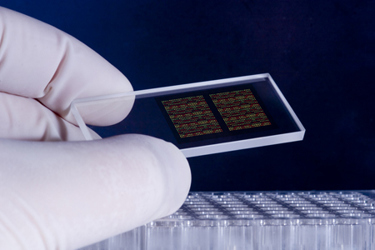Biochips: The Small Devices With Big Promise
By Shalini Nagar, Research Nester

Biochips are small, portable medical devices that have a variety of microarrays for carrying out many biochemical processes simultaneously. They come equipped with a range of biosensors that enable the screening of different biological materials like enzymes, proteins, DNA, biological molecules, antibodies, and more. They can also be implanted in the body to track a person’s health or control prosthetic limbs. Drug discovery, gene expression profiling, SNP genotyping, in-vitro diagnostics, agricultural biotechnology, and other fields make extensive use of biochips.
Market Overview
The biochips industry is projected to experience lucrative growth in the coming years. As per a report by Research Nester, the global market size for biochips is anticipated to surpass $35 billion by the conclusion of 2035 with a compound annual growth rate (CAGR) of 14% between 2023 and 2035. In 2022, the biochips sector had a market size of $8 billion, primarily driven by the increase in cases of immunodeficiency disorders in the world. Additionally, more than 430 different primary immunodeficiency disorders have been discovered to date.
The biochips market is segmented by type into DNA biochips, microfluidic biochips (also known as lab-on-a-chip), and protein chips. Their functions can be segmented into multipurpose, bifunctional, enzyme, and cleaning chips. The fabrication technologies include microarrays and micro fluids. Let’s take a closer look at the types of biochips, key applications, and more.
Functions And Technologies Of Biochips
With regard to function, there are multipurpose chips, bifunctional chips, enzyme chips, and cleaning chips. Each of these segments has unique features and applications. The market is mainly dominated by multipurpose chips, which hold a substantial 40% market share. These chips are widely used and are known for their versatility; they play a role in detecting DNA, RNA, and proteins, and find applications in research, drug discovery, and diagnosis.
Bifunctional chips are designed to perform functions simultaneously, finding utility in areas like drug discovery and diagnosis, where they can detect multiple analytes at once. Enzyme chips specialize in detecting enzymes, with use in drug discovery, diagnosis, and environmental monitoring. Cleaning chips are designed to prepare surfaces for biochip analysis.
The two fabrication technologies of biochips are microarrays and microfluidics. The microarray category currently dominates the market, and these are biochips that use a set of DNA probes to identify multiple genetic sequences within a single sample. They find usage in both research and diagnostic endeavors. Microfluidics is a technology focused on manipulating fluids at the microscale level and has applications in drug delivery and diagnostics.
Types Of Biochips
1. DNA Biochips
A set of DNA fragments positioned on strong surfaces is called a microarray or biochip. Researchers use these to determine the expression level of a large number of genes. The picomoles of specific genes, which are called probes, represent every DNA mark. In situations where rigidity is high, it could be a small segment of gene material. To determine the relative amount of nuclear acid series in a target, probe hybridization typically occurs and is measured by recognition of fluorophores or chemiluminescence labeled targets. The estimated 80,000 genes in human DNA were identified much more quickly thanks to biochips.
2. Microfluidic Biochips
In place of traditional biochemical labs, microfluidic biochips or "labs on chips" are revolutionizing a number of applications, including DNA analysis, molecular biology techniques, proteomics, the study of proteins, and clinical pathology for disease diagnosis. The use of thousands of components in these chips is making them more sophisticated, but the physical design of those components — known as a bottom-up, full-custom plan — requires a sizable staff.
3. Protein Chips
A protein microarray, also known as a protein chip, is a method used to follow the actions and connections of proteins and to find out their function on a large scale. The protein microarray helps in tracking a large number of proteins in parallel. This protein chip consists of a surface for support like a microtiter plate or bead, a nitrocellulose membrane, and a glass slide.
Applications Of Biochips
- Diagnostic Testing: Biochips can be used to quickly and accurately diagnose diseases like cancer and other chronic conditions such as diabetes, allowing patients to receive prompt treatment.
- Personalized Medicine: In the field of personalized medicine, the growth and scope of biochips are increasing. For some individuals, the use of biochips may be a way to tailor treatment. Furthermore, by using biochips to examine genetic data, physicians may be able to discover if a particular patient will benefit from treatment. In 2022, personalized healthcare, therapeutic drugs, and diagnostics were expected to constitute approximately 40% of the market.
- Drug Discovery and Development: The two key components of the medical sector are clinical research and drug discovery. With the help of biochips, it has become possible to discover new drug candidates and potential therapeutic targets swiftly and precisely.
- Drug Delivery: Biochips can be used in the drug delivery segment for precise dosing of medicines into a specific area of the body and to release certain drugs at specific times to treat different diseases.
- Tracking and Storing Health Data: Biochips are widely used for tracking a person’s health and medical history, storing medical records, and more. These chips are precise and help in measuring data more accurately than conventional approaches using microelectronics and nanotechnology. Because of their ability to analyze vast quantities of data that are suitable for processing and storage, biochips offer significant speed and greater efficiency compared with the techniques currently used. They enable the security of vital information and data, as well as provide an impenetrable storage environment.
Navigating The Challenges
Some harmful effects on the body can arise when using biochips and care should be taken at all times when using them. Because they can contain toxic substances or metals, biochips may lead to an allergic reaction or more serious health problems. In addition, biochips are also capable of storing personally identifiable data, which could pose potential security and privacy concerns.
The industry faces a hurdle in the form of high expenses associated with developing and producing biochips. These expenses arise due to factors, such as the complexity involved in designing and fabricating them, the costly raw materials and equipment needed for manufacturing, and the limited scalability of production processes. To tackle these challenges, companies are actively exploring alternative manufacturing techniques and materials that can lower costs while also enabling scalability. For instance, some companies are delving into the realm of 3D printing and microfluidics as solutions to simplify the manufacturing process and make it more cost effective.
Moreover, the lack of standardization in the design and manufacturing procedures poses a hurdle. A lack of standardization can result in variations in performance and outcomes, thereby making it challenging to compare data from studies and experiments. In order to tackle this obstacle, industry associations are actively engaged in establishing protocols and recommendations for biochip design and manufacturing. The objective behind these endeavors is to guarantee reliable production of biochips regardless of the manufacturer or specific application.
Key Players In The Biochips Market
- Opteev Technologies provides products and services for immunodeficiency disorders. One of their known products is a new multiplex biochip that can easily identify flu, RSV, and respiratory pathogens.
- ACROBiosystems provides products for escalating neurological drug discovery. The company has recently launched in vivo electrophysiology solutions for neuroscience research with diagnostics biochips.
- Toray Industries Inc. has launched an allergy-testing biochip that can help in measuring multiple allergen-specific immunoglobin E antibodies from trace amounts of blood.
- Merck KGaA has partnered with Artios Pharma in order to identify multiple synthetic lethal targets for precision cancer drug candidates.
Recent Innovations
- A biochip that can be used for screening a thousand molecules, and which has been successfully tested with live viruses, was developed by Stanford University's materials scientists and engineers working in collaboration with an ETH Zurich scientist and another from Washington University. They've presented their work in the journal Nature Communications. The researchers believe that their biochip could serve both as a tool for diagnosis and an aid in research. They also used it to detect SARS COV2 protein fragments to further prove its usefulness.
- At TU Wien Vienna, biochips have been developed that could be used to generate and analyze tissue. In this way, the tissues can be provided with various substances in a highly controlled manner.
The next trend in biochips will include the ability to provide applications across a wide range of areas, from identifying rare organisms to population-based clinical trials, following the emergence of scaling and throughput power of biochip technologies.
Conclusion
Biochips have the potential to revolutionize the healthcare sector. These small devices have the ability to improve diagnostics, monitor health conditions, and deliver targeted treatments. Nonetheless, the challenges and ethical implications of their implementation need to be addressed. Continued research and development will be essential in order to unlock the full potential of biochips as we move forward.
 About The Author:
About The Author:
Shalini Nagar is a content associate at Research Nester Pvt. Ltd.
